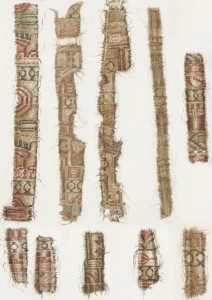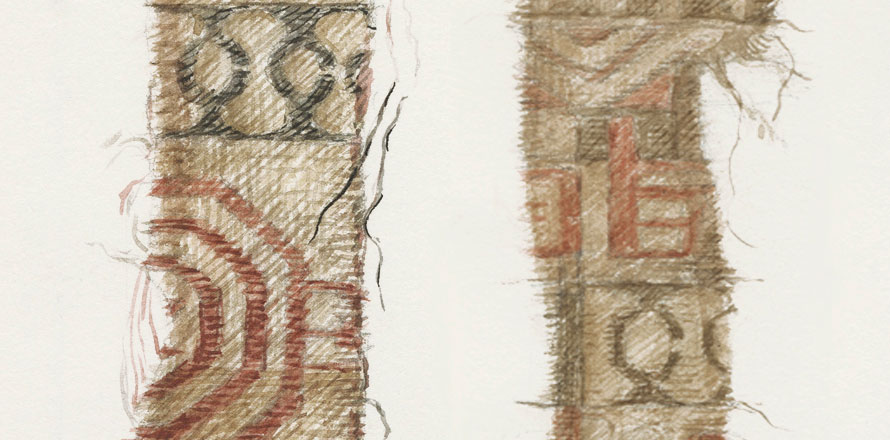Silk has been found in abundance in Viking Graves both in Oseberg, Birka and Haithabu witnessing to a lively long-distance trade with Persia in the 9th and 10 century
Silk was treasured amongst the Vikings and definitely considered a precious object. This is obvious from the fact that it was usually cut into stripes and used as borders on jackets, caftans and dresses – something, which has been found in for instance the many graves in Birka in Sweden, which contained fragments of silk among the other textiles preserved there. During the last four years such fragments of Viking silk has been intensely studied by Marianne Vedeler from the Museum of Archaeology in Oslo.

Aquarelles by Sofie Kraft
© KHM – UiO
Foremost, however, her work has focused on the silk-stripes from Oseberg, the famous Viking ship burial from 834 AD. No grave has yielded as much or as diverse a collection of silk-fragments as this. In Oseberg, alone, silk from more than 15 different textiles, has been identified. To this should be added silk used locally for tablet-woven bands and embroidery.
When the Oseberg Silks were discovered in 1904 -05 the colours were still vibrant and the patterns easily detected as can be seen from the aquarelle sketches made by Sofie Krafft. Later they faded and today the patterns cannot be seen directly. For the last four years the silks have once more been studied intensely in order to evaluate the original illustrations plus see if it is possible to find further information about the patterns.
The detailed analysis of these fragments has shown that the silk was possibly bought directly in Persia and not in Byzantium and that it did not belong to the best quality, which was only obtainable as diplomatic gifts. Some may have been plundered in Viking raids as part of church vestments.
However, since the Oseberg excavation, silk from the Viking Age has been found in several other locations in the Nordic countries. The last finds were made two years ago at Ness in Hamarøy municipality, Nordland county. Other Norwegian finds of silk from the Viking Age include Gokstad in Vestfold county, Sandanger in the Sunnmøre district and Nedre Haugen in Østfold county. The wide dissemination in graves from the 9th and 10th century, however, points to the fact that most of it must have been obtained as part of trading ventures along the Russian rivers.
The result of the work of Marianne Vedeler is currently being prepared for publication in a new book scheduled for 2014. Here she takes a closer look not only at the silk itself, but also the trade routes and the organization of production, trade and consumption of silk during the Viking Age. The main trade routes of silk to Scandinavia along the Russian rivers, and comparable Russian finds are described and the production and regulation of silk in Persia, early Islamic production areas and the Byzantine Empire is discussed. The final chapter considers silk as a social actor in various contexts in Viking societies compared to the Christian west.
SOURCE:
Norwegian Vikings purchased silk from Persia
READ MORE:
Silk for the Vikings
Series: Ancient Textiles Series, Volume: 15
By Marianne Vedeler
Language: English, Paperback, 120p , £20 – 25
Oxbow Books 2014
ISBN: 9781782972150
